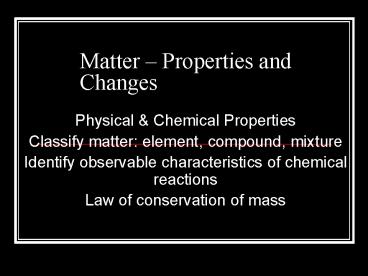Matter Properties and Changes - PowerPoint PPT Presentation
1 / 30
Title:
Matter Properties and Changes
Description:
Identify observable characteristics of chemical reactions. Law of ... Cutting paper, breaking a beaker, ... Chemical Changes. Referred to as a chemical reaction ... – PowerPoint PPT presentation
Number of Views:52
Avg rating:3.0/5.0
Title: Matter Properties and Changes
1
Matter Properties and Changes
- Physical Chemical Properties
- Classify matter element, compound, mixture
- Identify observable characteristics of chemical
reactions - Law of conservation of mass
2
Substance
- Matter that has a uniform and unchanging
composition - Salt, water, 3M HCl,
3
Physical Property
- A characteristic that can be observed of measured
without changing the samples composition
4
Physical Properties
- Extensive properties
- Dependent on the amount of substance present
- Mass, length, volume,
- Intensive properties
- Independent of the amount of substance present
- Density
5
Chemical Properties
- The ability of a substance to combine with or
change into one or more other substances - Rust,
6
States of Matter
- Changing between physical phases depending on
temperature and/or pressure - Melting Boiling points
- Solid
- Liquid
- Gas
- Plasma
- The way it fills a container
7
Solids
- Form of matter that has its own definite shape
and volume - Tightly packed particles
- Expands when heated
8
Liquids
- A form of matter that flows, has constant volume
and takes the shape of its container - Particles move past each other
- Particles expand when heated
9
Gases
- Form of matter that flows to conform to the shape
of its container and fills the entire volume of
the container - Easily compressed
- Vapor
- Gaseous state of a substance that is a solid or
liquid state at room temperature
10
Physical Changes
- Changes that alter the a substance without
changing its composition - Cutting paper, breaking a beaker,
11
Chemical Changes
- Referred to as a chemical reaction
- New substances formed in the reaction have
different compositions and different properties
from the substances present before the reaction
occurred
12
Conservation of mass
- States that mass is neither created nor destroyed
in any process it is conserved. - Massreactants Massproducts
- Antoine Lavoisier
- Analytical balance
- Mercury (II) oxide yeilds mercury oxygen
- 216 g 200 g 16 g
13
Mixtures
- Combination of 2 or more pure substances in which
each pure substance retains its individual
chemical properties - Salt and water or sand and water
14
Types of mixtures
- Heterogeneous mixture
- Does not blend smoothly throughout and in which
the individual substances remain distinct - Sand and water
15
Types of mixtures
- Homogeneous mixture
- Has consistent composition throughout, it always
has a single phase - Solutions
- Solid, liquid or gas
16
Separating Mixtures
- Filtration
- Uses a porous barrier to separate a liquid from a
solid - Distillation
- Based on differences in boiling points of the
substances involved
17
Crystallization
- Separation technique that results in the
formation of pure particles of a substance from a
solution containing the dissolved substance
18
Chromatography
- Technique that separates the components of a
mixture on the basis of the tendency of each to
travel or be drawn across the surface of another
material
19
Elements
- A pure substance that cannot be separated into
simpler substances by physical or chemical means - 91 occur on earth naturally
- Cu, O, Ag
20
Periodic Table of Elements
- Organizes elements into a grid of horizontal rows
called periods and vertical columns called groups
or families
21
Dmitri Mendeleev
- Based on similarities and masses
- Could accommodate for elements that had not even
been discovered yet - Was able to predict the properties of elements
that were not yet discovered
22
(No Transcript)
23
Compounds
- Combination of two or more different elements
that are combined chemically - Water, salt, sugar, aspirin
24
(No Transcript)
25
Law of Definite Proportions
- States that, regardless of the amount, a compound
is always composed of the same elements in the
same proportions by mass - Percent by mass
- The ratio of the mass of each element to the
total mass of the compound as a percent - Percent by mass () (mass of element / mass of
compound) x 100
26
Copper Carbonate
27
Sucrose Analysis
28
Law of Multiple Proportions
- States that when different compounds are formed
by combinations of same elements, different
masses of one element combine with the same
relative mass of the other element in a ratio of
small whole numbers.
29
Analysis Data of Two Copper Compounds
30
Compare ratio of mass of copper to the mass of
chlorine for each compound
- Mass ratio compound I / mass ratio compound II
- 1.793 g Cu/g Cl / 0.896 g Cu/g Cl 2.000































